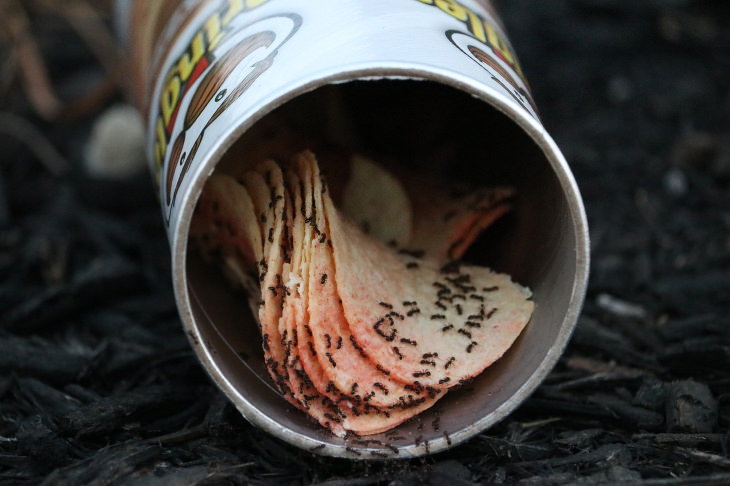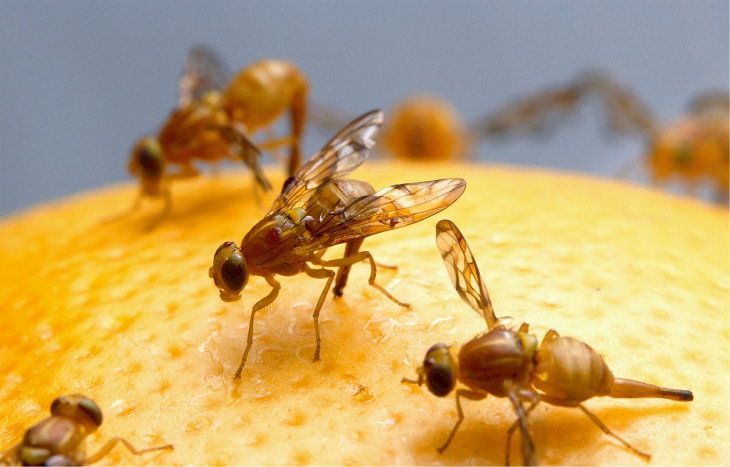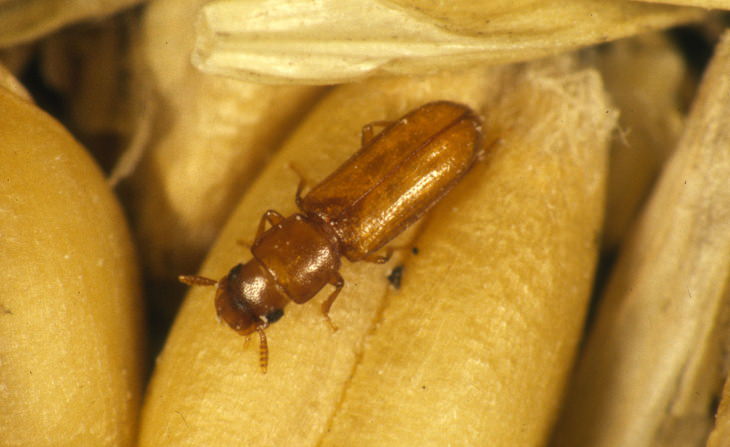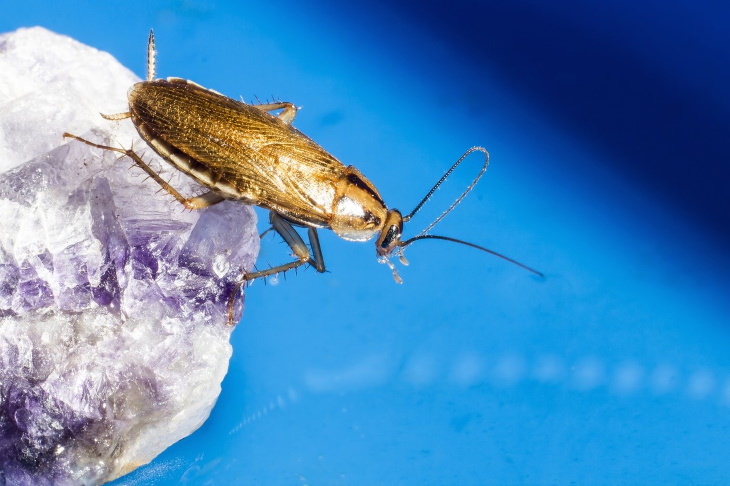1. Ants
Ants are probably the most widespread pest out there, and ant infestations are fast, ruthless, and sometimes impossible to take care of on your own. So, the moment you see one or two ants in your home, it's advisable to start acting immediately to prevent it from becoming a long-term problem. There are over 700 ant species, and the way you get rid of the pest will depend on the species, so if your ant problem isn't gone although you've tried everything, it may require a visit from a pest control specialist.
How to get rid of it:
The best way to get rid of ants is to prevent them from getting into your home. This is because ants typically don't live in your home or pantry, unlike other pests, they live in large colonies outside instead and get into your home every day through cracks in the doors and windows. You can use natural deterrents you likely already have at home, such as talcum powder, salt and pepper, and bay leaves at suspected points of entry. To learn more about treating an ant infestation, read our previous article titled Natural Ways of Keeping Ants at Bay.
2. Fruit Flies
Fruit flies, too, are extremely annoying, as they're super tiny and multiply way too quickly. These pests typically get into your home through infected fruit and veggies, and their eggs can stick to plastic bags, too, so it often happens that they hatch in your pantry and start wreaking havoc around everything that's even remotely sweet - honey, maple syrup, jam, or even unnoticeable sugar stains on the floors or kitchen counters.
These pests are extremely widespread and they are bound to develop in most fruit and veggies left at room temperature because they feed on fermented sugar that develops as foods become overly ripe, so make sure you go through your fruit and vegetable storage regularly and throw away everything that seems remotely off.
How to get rid of it: Fruit flies are afraid of vinegar, wine, salt, and pepper, so you can disinfect any boxes or shelves infested by fruit flies with vinegar diluted 1:1 with water and sprinkle salt or pepper in any high-risk areas. You can also try to trap fruit flies in a DIY trap. For ideas on how to make a fruit fly trap, read our article 7 Novel Ways of Trapping Fruit Flies.
3. Grain Weevils
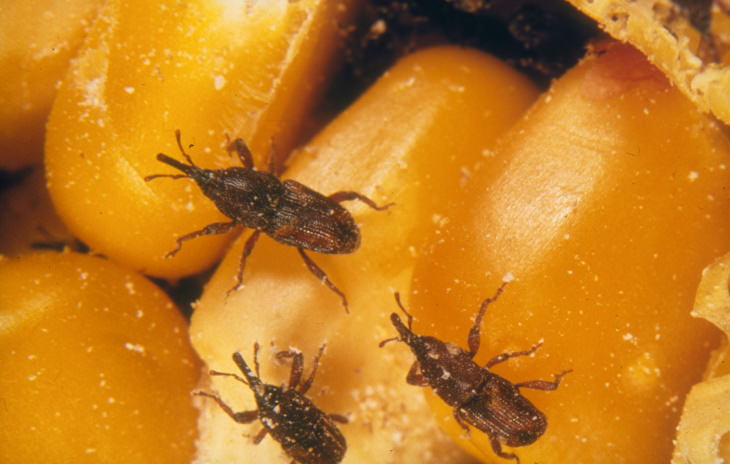
These guys don't want your fruit or sugar, instead, they're after your grains and even beans. Also known as granary or wheat weevils, grain weevils live and feed on whole grains, nuts, beans, and seeds. You can recognize these rather small brown bugs by their elongated snouts. These guys can get into your pantry from the outside, but more often than not, they're already present in the grain you buy from the supermarket, so make sure to check the package of the grain for holes and look closely at the grain itself if possible before buying it.
How to get rid of it: Grain weevils can chew their way through paper and plastic packaging, but not glass, metal, or hard plastic container. So, the best way to prevent them from spreading is by storing grains, nuts, beans, and seeds in airtight containers made of glass, hard plastic, or metal.
If you find that one container is infested with weevils, empty it into the trash and take out the trash into the garbageimmediately - it's safer to lose just one kind of food than having to clear out the entire pantry just a few weeks later. Small bags of black pepper placed strategically onto the pantry shelves are also known to repel granary.
4. Flour Beetles
Yet another common pest that's after your cereal and flour are flour beetles. Unlike weevils, they cannot feed on whole grains, though. These bugs are tiny, measuring in at 5 mm or even less, and there a few species of them, such as the hilariously named confused flour beetle and the red flour beetle. Like weevils, they live and reproduce in your food, and they can penetrate paper and thin plastic packaging. Although these reddish-brown pests are not dangerous to humans per se, they can make flour, cereal, and pet food smell funky and cause discoloration.
How to get rid of it: Controlling a flour beetle infestation is similar to preventing weevils from spreading - transfer cereal, flour, and pet food from the original plastic or paper package into a sealed glass, hard plastic, or metal container, and even if you do, throw out the entire package if you notice any traces of the beetles.
5. Indian Meal Moths
Here's yet another familiar face - the Indian meal moth, one of the most common and notorious pantry pests in the world. You can easily recognize these winged pests by their reddish-brown wings. Also known as the pantry moth or flour moth, Indian meal moths are keen on tasting most of the stuff we store in our pantries, from dried fruit to nuts, grains, cereals, and processed foods like cookies and crackers. Since they're anything but picky eaters, pantry moth infestations are often difficult to control and tend to spread like wildfire through your pantry, so it's important to act fast.
How to get rid of it: Flour moths are extremely sneaky - they lay eggs on the corners of shelves, the cracks in the pantry door, and even the bottoms of jars, so the first thing you must do to get rid of them is to clean everything in your pantry and the pantry itself as thoroughly as possible, preferably wiping everything down with a vinegar and water cleaning solution to disinfect the area.
Just like you'd deal with other pests, it's also important to transfer any unaffected foods into tightly-sealed containers, as the moths are small enough to squeeze through tiny gaps in bags and mesh, and they are known to chew through cardboard boxes and plastic bags, too. As for the foods infested by Indian meal moths, it's safer to just throw them away.
6. Cockroaches
Known to survive huge doses of radioactivity, cockroaches are infamous for their resilience and ability to infest a home for years and years. On top of it all, they're pretty creepy, too, if you ask me. In most cases, cockroaches infiltrate your home through seemingly harmless objects, such as vintage furniture, boxes, and they are known to even live in electrical appliances, ugh.
They can also crawl out of sewers or drains and get into your home that way. Once they're inside, they can easily get from one room to another through electrical lines and pipes and create nests in any of the above-mentioned places, which makes them very difficult to exterminate. If you see one cockroach in your home, assume that there are more, and act asap.
How to get rid of it: The first thing you can do if you see cockroaches in the pantry or cabinet is empty it completely of food. Having lost their source of food, the cockroach population will weaken, which will make extermination much easier. In addition, make sure to throw out the trash daily, clean out any morsels of food from the floors, kitchen counters, tables, and even the sink, so that the cockroaches have nothing to eat.
Once you made sure that your kitchen is free of food accessible to cockroaches, you can start exterminating them by either calling in professional help or consulting our article dedicated to cockroach extermination titled How to Get Rid of Roaches: What Works and What Doesn't.
Share this article with those who might find it useful

